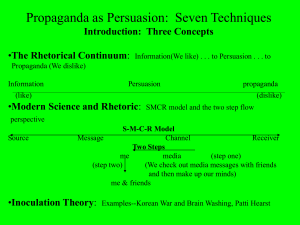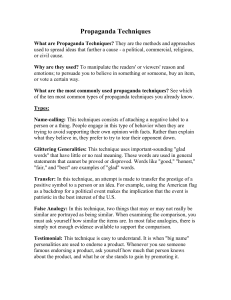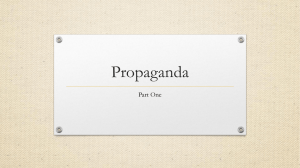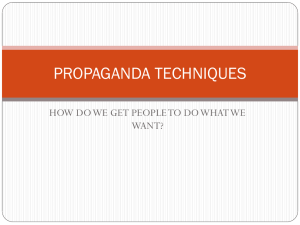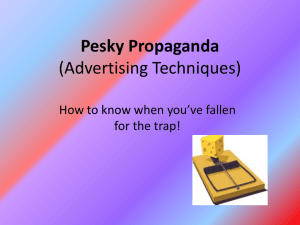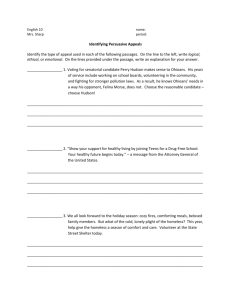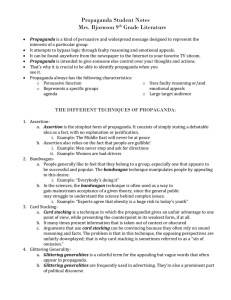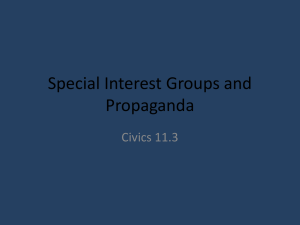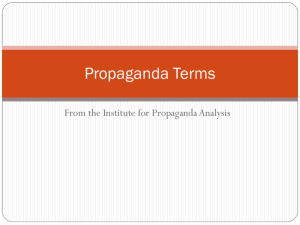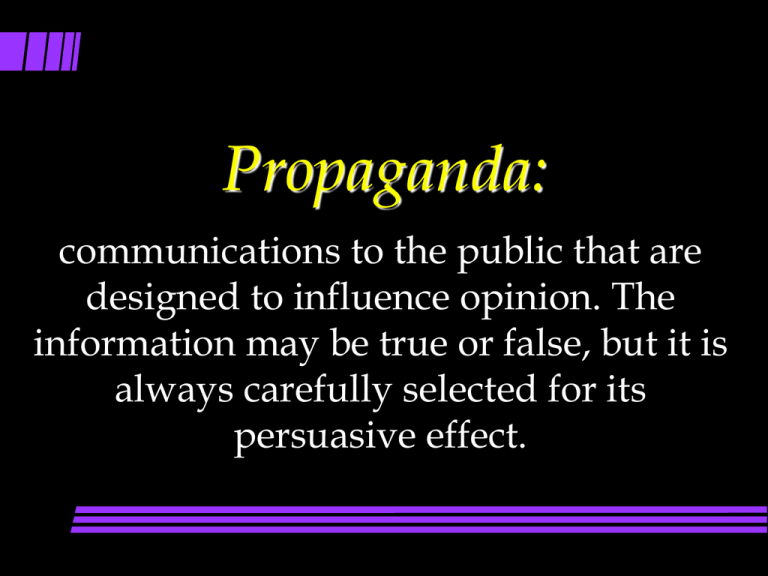
Propaganda:
communications to the public that are
designed to influence opinion. The
information may be true or false, but it is
always carefully selected for its
persuasive effect.
Propaganda differs from
persuasion in that
Propaganda appeals to the emotions,
while argument appeals to reason.
Propaganda often has a negative
connotation. Propaganda is often used in
advertising and politics—any time
someone is trying to convince another.
Negative Connotation of
Propaganda
• “The receptivity of the masses is very limited,
their intelligence is small, but their power of
forgetting is enormous. In consequence of these
facts, all effective propaganda must be limited
to a very few points and must harp on these in
slogans until the last member of the public
understands what you want him to understand
by your slogan.”
― Adolf Hitler
• “I use emotion for the many and reserve reason
for the few.”
― Adolf Hitler
7 Types of Propaganda
1. Name
calling
2. Glittering
generalities
3. Transfer
4. Testimonial
5. Plain Folks
6. Card Stacking
7. Band Wagon
BANDWAGON:
•Think "getting on the
bandwagon." This gives the
idea that everyone is doing
this, or everyone supports
this person/cause, so should
you.
BANDWAGON:
•EXAMPLE: Everyone in
Lemmingtown is behind Jim
Duffie for Mayor. Shouldn't
you be part of this winning
team?
TESTIMONIAL:
•This is the celebrity
support of a
philosophy, movement
or candidate.
TESTIMONIAL:
•EXAMPLE: "Sam Slugger", a
baseball Hall of Famer who
led the pros in hitting for
years, appears in a television
ad supporting Mike Politico
for U.S. Senate.
PLAIN FOLKS:
•The candidate or cause
is identified with
common people from
everyday walks of life.
Plain Folks
•EXAMPLE: After a
morning speech, Bill
Clinton stops
by McDonald's for a
burger, fries, and
photo-op.
TRANSFER:
•Use of symbols, quotes,
or the images of famous
people to convey a
message not necessarily
associated with them.
TRANSFER:
•An advertiser might use a
flag to connect his
product with patriotism.
GLITTERING GENERALITIES:
•Closely related to TRANSFER. A
generally accepted virtue is used
to stir up favorable emotions. The
problem is that these words mean
different things to different people
and are often manipulated for the
propagandist’s use.
GLITTERING GENERALITIES:
•EXAMPLE: An ad by a
cigarette manufacturer
proclaims to smokers: Don't
let them take your rights
away!
NAME-CALLING:
•This is the opposite of the
GLITTERING
GENERALITIES approach.
Name-calling ties a person or
cause to a largely perceived
negative image.
NAME-CALLING:
•EXAMPLE: In a
campaign speech to a
logging company, the
Congressman referred to his
environmentally conscious
opponent as a "tree hugger."
CARD STACKING:
•This device tells only part of
the truth. It overemphasizes
or underemphasizes to avoid
issues and manipulate facts.
Card stacking made include
use of red herrings.
CARD STACKING:
•Example: CleanWhite
toothpaste gets your teeth 50%
cleaner. (Omitting the fact that
the statistic means 50% cleaner
than NOT brushing.)
Advertising Appeals
Appealing to
Emotions
Uses
• Advertising.
• Politics.
• Any place someone uses
emotional appeals rather
than logic to get
something.
In Advertising:
Claims about the product
• It will change your life!
• It will meet an essential
need!
• It will solve your
problems!
Appeal to emotions:
Especially for Instinctive
Needs
• Survive
• Security
• Sex
• Altruism
• Curiosity
• Adventure
• Belonging
• Health
Instinctive needs
• Instinctive needs are feelings
we have naturally; we don’t
have to learn them.
Appeal to emotions:
Cultural Values
• Youth/beauty
• Entertainment
• Value $
• Succeed
• Status
• Easy and convenient
Cultural Values
• Our culture often makes us
feel as if we need something
that we really don’t need.
• We learn this through seeing
culture around us.
Typical format: Parable
• Ad tells a story
• Person has problem/need
• Discovers product
• Problem solved
Instinctive and Cultural
Appeals
•
•
•
•
•
•
Youth/beauty
Entertainment
Value $
Succeed
Status
Easy and
convenient
•
•
•
•
•
•
•
•
Survive
Security
Sex
Altruism
Curiosity
Adventure
Belonging
Health
values
relating to human conduct, with
respect to the rightness and wrongness
of certain actions and to the goodness
and badness of the motives and ends of
such actions.
Appeal
to the audience’s values
regarding the sense of right and wrong.
Shared values
•
•
•
•
•
•
•
Honesty
Fairness
Value of life
Equality
Justice
Trust
Freedom of choice

